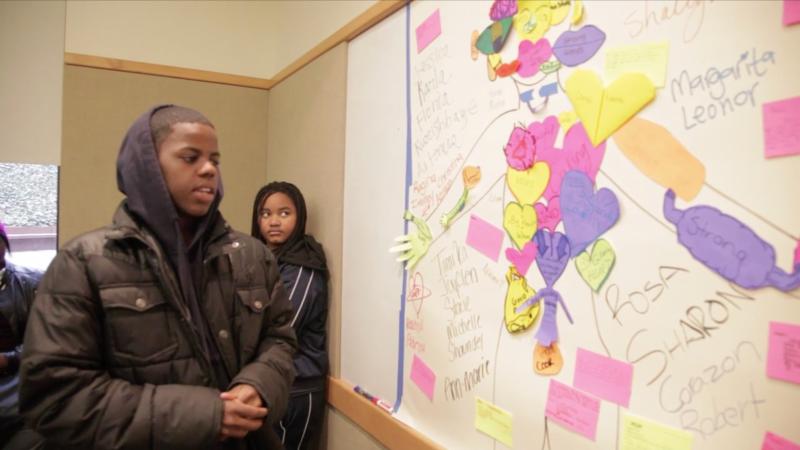The Youth and Gender Media Project (5 Film Package)
Introduction
The Youth and Gender Media Project consists of five short films that capture the diversity and complexity of gender nonconforming youth. These award-winning films provide students and educators with unique tools to explore critical questions about gender identity and family acceptance, and are ideal for discussions about bullying and inclusiveness. When you purchase this package of five films, you get it for the price of four.
Featured review
Synopsis
Mama has a Mustache is a short, quirky, fully animated documentary about gender and family, as seen through children’s eyes. Driven completely by audio interviews of kids ages 5-10, the film uses these sound bytes combined with clip-art and mixed media to explore how children are able to experience a world outside of the traditional gender binary.
Becoming Johanna tells the story of a sixteen-year-old transgender Latina living in Los Angeles who is kicked out of school for using the girls bathroom, then forced out of her home when her religious, immigrant mother refuses to accept her transition to a young woman. Through her fierce determination and boundless resilience, Johanna finds a foster family who loves her and a supportive school principal who helps her to graduate and thrive.
Creating Gender Inclusive Schools provides a behind-the-scenes look at a public elementary school that trains their entire school community—students, teachers, parents and staff—about gender, inclusivity, stereotyping, and bullying. Told primarily through the voices of students and teachers, the film demonstrates that it’s not only possible, but that it’s downright fun, to train an entire public elementary school community to be inclusive of transgender and gender expansive youth.
I'm Just Anneke is a portrait of a 12-year-old girl who loves ice hockey and has a loving, close-knit family. Anneke is also a hardcore tomboy and everybody she meets assumes she's a boy. The onset of puberty has created an identity crisis for Anneke. Does she want to be a boy or a girl when she grows up, or something in between? To give her more time to make a decision, her doctor has put her on Lupron, a hormone blocker that temporarily delays the hormones of adolescence. Despite rejection by her friends and struggles with suicidal depression, Anneke is determined to be true to herself and maintain a gender fluid identity that matches what she feels on the inside. I'm Just Anneke takes us into the heart of a new generation of children who are intuitively questioning the binary gender paradigm.
The Family Journey: Raising Gender Nonconforming Children charts the emotional and intellectual transformations parents and siblings must make in order to successfully nurture their gender nonconforming family members. In frank, vulnerable interviews, families from all over the country speak about the power of love and acceptance to help their unusual children thrive. They also come to realize that loving a gender nonconforming child, in the face of ignorance and sometimes hostility, has turned them into more compassionate human beings.
Our films introduce profoundly new concepts, like the idea that even a young child can be transgender and the new and still rare use of hormone blockers to delay puberty. Universal themes like family acceptance, being true to one’s self, coming of age, the power of community, and the importance of tolerance and love make these films accessible and deeply moving, even to people who may be resistant to the idea of transgender youth.
Reviews
Awards and Screenings
Director Commentary
Features and Languages
Film Features
- Audio Description
- Closed Captioning
- Resources for Educators
Film/Audio Languages
- English
Subtitle/Caption Languages
- Spanish

























I was a gender nonconforming child who loved to play with both dollhouses and Hot Wheels, wear pants and dresses. Like any child, I wanted it all! Around second grade, I started to get teased and bullied for my “sissy” ways and decided to give up “girly” things in order to evade the harassment that I intuitively knew would only get worse as I grew older. But this also meant that I abandoned an important part of myself.
In the early 2000s I began to read about children who were gender creative and transgender and were living in communities that supported them. These children and their families were doing what my community hadn’t been able to do when I was a child. As a social change filmmaker, I wanted to document and help grow the movement that embraces rather than suppresses children with gender expansive identities.
In 2007, I began work on a film that eventually turned into the Youth & Gender Media Project, a series of short films about gender expansive young people and their families and communities. I’m happy to say that the films have screened in festivals around the world and are being used in hundreds of middle schools, high schools and colleges throughout North America to help make the world safe for youth of any and all manifestations of gender identity and expression.